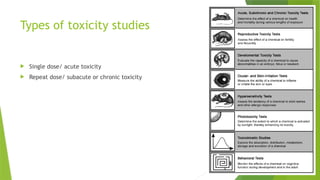Toxicity studies.pptx and its guidelines
- 2. Introduction ’üĄ Toxin is a substance that is any of these: dangerous, harmful, unsafe, injurious, poisonous, undesired or fatal. ’üĄ Toxicology is a branch of pharmacology concerned with the study of adverse effects of chemicals, biologicals and physical agents on living organisms ’üĄ Relationship between dose and adverse effects ’üĄ All things are poisonous and nothing is without poison; only the dose makes a thing not poisonous.
- 3. Factors that influence toxicity ’üĄ Dosage ’üĄ Both large single exposures (acute) and continuous small exposures (chronic) are studied. ’üĄ Route of exposure ’üĄ Ingestion, injection, inhalation or skin absorption ’üĄ Other factors ’üĄ Species ’üĄ Age ’üĄ Sex ’üĄ Health ’üĄ Environment ’üĄ Individual characteristics
- 4. Methods of conducting toxicity studies ’üĄ In vivo ’üĄ Ex vivo ’üĄ In vitro ’üĄ In silico ’üĄ Before conducting any toxicological testing in animals or collecting tissue or cell lines from animals, the study should be approved by the IAEC or the protocol should satisfy guidelines of local governing body
- 5. Animals used for toxicity testing
- 6. Types of toxicity studies ’üĄ Single dose/ acute toxicity ’üĄ Repeat dose/ subacute or chronic toxicity
- 7. Key factors for designing toxicity studies ’üĄ Selection of species/ strain/ sex ’üĄ Age ’üĄ Number ’üĄ Interim necropsy ’üĄ Infection during study ’üĄ Caging ’üĄ Diet ’üĄ Mortality ’üĄ Autolysis
- 8. Key factors for designing toxicity studies ’üĄ Identity ’üĄ Composition/ purity ’üĄ Storage ’üĄ Exp Date
- 9. Key factors for designing toxicity studies ’üĄ Duration of testing ’üĄ Route of administration ’üĄ Diet ’üĄ Drinking water ’üĄ Oral gavage
- 10. Key factors for designing toxicity studies ’üĄ Treatment doses ’üĄ Controls
- 11. Observations and Clinical tests ’üĄ Daily observation for changes in skin, fur, eyes, mucous membranes, secretions, excretions, autonomic activity (lacrimation, pilorection, pupil size, unusual respiratory pattern) ’üĄ Changes in gait, response to handling, stereotypes (excessive grooming, repetitive circling) or bizarre behavior (self-mutilating, walking backwards) ’üĄ Body weight ’üĄ Feed and water intake
- 12. Clinical testing to support observations ’üĄ Opthalmological examination ’üĄ Hematology ’üĄ Clinical chemistry ’üĄ Urinalysis ’üĄ Neurotoxicity ’üĄ Immunotoxicity
- 13. Necropsy ’üĄ Gross necropsy ’üĄ Organ weight ’üĄ Microscopy












